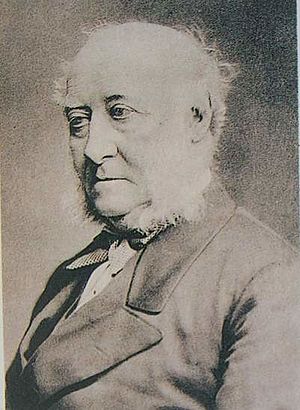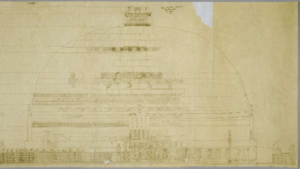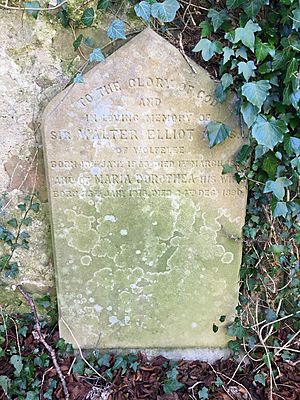Walter Elliot (naturalist) facts for kids
Sir Walter Elliot (born January 16, 1803 – died March 1, 1887) was an important British government worker in colonial India. He was also a famous expert in many fields, including languages, ancient history, nature, and cultures. He mostly worked in the Presidency of Madras, a large area in southern India controlled by the British.
Born in Edinburgh, Scotland, Walter Elliot studied at the East India Company College in Haileybury. He joined the East India Company's government service in Madras in 1820 and worked there until 1860. In 1866, he was given a special honor, becoming a Knight Commander of the Order of the Star of India (KCSI).
Contents
Early Life and Education
Walter Elliot was born in 1803 in Edinburgh. His father was James Elliot, and his mother was Caroline Hunter. He was taught at home by a private tutor and later went to school near Doncaster, England.
After school, he attended Haileybury College. He did very well there, graduating with "high distinction." In January 1819, he got a job as a "writer" for the East India Company's Civil Service. This job was helped by his great-uncle, William Fullerton Elphinstone, who was a director of the company. Walter Elliot arrived in Madras, India, on June 14, 1820.
Working in India
Elliot continued his training at a college in Fort St George in Madras. He was very good at learning languages. He even won an award for how well he spoke Tamil and Hindustani. Later, he learned other languages like Kannada, Marathi, Arabic, Persian, and Telugu.
For two years, he worked as an assistant in the Salem district. Then, he moved to a newly taken over area called the southern Maratha district.
In 1824, Elliot was involved in the Kittur uprising, where people tried to take back their land from British control. He was captured and held prisoner for six weeks. During this time, he was treated well by his captors. He learned a lot about Hindu customs and social groups.
Later, the southern Maratha district was moved under the control of the Bombay Presidency. However, the governor, Sir John Malcolm, allowed Elliot to stay. During this period, he became known as an adventurer, a historian, a big-game hunter, and a language expert.
Trip to England
On December 11, 1833, Elliot left India to visit England. He traveled through the Red Sea and rode across the desert in Egypt. He then sailed down the Nile River and visited famous cities like Cairo, Constantinople, Athens, and Rome. He arrived in England on May 5, 1835.
In 1836, Elliot's cousin, John Elphinstone, 13th Lord Elphinstone, became the Governor of the Madras Presidency. Elliot became his private secretary. They sailed back to Madras together on a yacht given to them by the ruler of Muscat. They reached Madras in February 1837.
Back in India: Important Roles
Elliot worked with Governor Elphinstone until 1842. After Elphinstone retired, the new governor found Elliot doing many different jobs, even beyond his role as a private secretary. He also worked as a translator for the government.
In 1845, Elliot was sent to investigate the Guntur district. This area had been badly affected by a major famine in 1833 and was still struggling. Elliot discovered a lot of corruption among local leaders and officials. The East India Company was impressed by his work. They appointed him as commissioner of the Northern Circars, a very important position. He held this job until 1854.
After that, he became a member of the Council of the Governor of Madras. In 1858, Elliot temporarily served as the provisional governor of Madras. It was his job to announce a huge change: the Indian Rebellion of 1857 meant that the East India Company would no longer rule India. Instead, the British government (the The Crown) would take over, starting what was known as the British Raj.
Towards the end of his time in India, Elliot began to lose his eyesight. He retired from his service in 1859.
His Research and Discoveries
While in India, Elliot kept a detailed diary, writing notes on many different topics. He also wrote articles for scholarly journals. In 1859, he published a book called Flora Andhrica, which listed plants from the Northern Circars with their Telugu and English names. In 1840, he wrote about ancient stone structures found in the Nilgiri hills.
In 1845, he dug up and collected important sculptures from the Amaravati Stupa, an ancient Buddhist monument. These sculptures were sometimes called the "Elliot Marbles." Some of them went to London and are now in the British Museum. The main part of the collection is in the Government Museum, Chennai in India.
Elliot also studied ancient writings, beliefs, and cultures. He was very interested in old coins and collected many of them. His main book on coins, Coins of Southern India, was published in 1885. By this time, he was completely blind, so he had to feel the coins to describe them, and someone else wrote down what he said.
He also helped create a book called Carnataca Translation of Esop's Fables.
Interest in Animals
Elliot was very interested in the local animals of India. He spent a lot of time outdoors in his early years there. He even wrote letters to the famous scientist Charles Darwin. At Darwin's request, Elliot sent him skins of different domestic birds from India and Burma in 1856. He also worked with other naturalists in India, like Thomas C. Jerdon.
He collected many animal specimens, including shells, whales, and dolphins. These were studied by experts in Britain. He made a list of mammals found in southern India and described several new small mammal species. Two animals are named after him: the rat species Golunda ellioti and the Madras tree-shrew Anathana ellioti. Two types of Indian reptiles are also named after him: Monilesaurus ellioti and Uropeltis ellioti.
Elliot's home in Madras was a popular meeting place for scholars in the region. He encouraged many other researchers. Even after he returned to Scotland, his family home became like a museum. He remained active until the day he died. On March 1, 1887, he dictated and signed a letter about a new edition of a Tamil book. He passed away that same evening.
Retirement in Scotland
Elliot returned to his home in Wolfelee, Scotland, in 1860. He continued his research there. In 1866, he was made a Knight Commander of the Star of India. In 1878, he was chosen as a Fellow of the Royal Society, a very respected group of scientists. He also received an honorary degree from the University of Edinburgh in 1879.
He continued to serve his local community as a deputy lieutenant and a judge. A special memorial was placed in the Hobkirk Parish Church in his honor.
Family Life
On January 15, 1839, Walter Elliot married Maria Dorothea Hunter Blair in Malta. They had four sons and two daughters. The famous bird expert Philip Lutley Sclater was married to Maria Dorothea's sister.
- James Thomas Spencer Elliot (1845–1892)
- Walter Blair Elliot (1847–1869)
- Caroline Elliot (1852–after 1887)
- Edward (1852–1920), who played football for Scotland.
- Herman Elliot (1854–1895)
- Dorothea Helen Elliot (died 1925)
Selected Writings
Walter Elliot wrote many important papers and books, including:
- Hindu Inscriptions (1840s) – about ancient Indian dynasties.
- A Catalogue of the Species of Mammalia found in the Southern Mahratta Country (1839) – a list of mammals.
- Carnataca Translation Of Esop's Fables (1840) – a translation of Aesop's Fables.
- Flora Andhrica (1858-9) – about plants in the Telugu regions.
- Coins of Southern India (1885) – his main work on ancient coins.
- On the Habits of the Indian Rock-Snake (Python molurus) (1870) – about the behavior of pythons.





